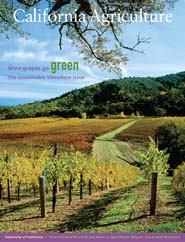All Issues

Wine grapes go green: The Sustainable Viticulture issue
Cover:
The grape-growing industry, in partnership with UC scientists, has aggressively promoted sustainable viticulture practices that are environmentally friendly, economically viable and socially responsible. In the Carmel Valley, a wine-grape vineyard shows its fall colors. Photo: David Gubernick/AGStockUSA
October-December 2008
Volume 62, Number 4
Volume 62, Number 4





